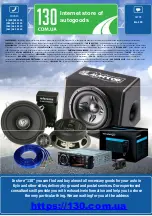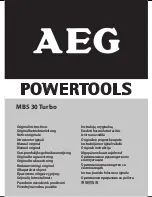
5
Fig. B
Rotational
Kickback
Kickback
Danger Zone
Saw Chain
Direction
KICKBACK SAFETY
Understanding Kickback
A basic understanding of kickback can help reduce or eliminate the
element of surprise and the chance of kickback-related injury.
Sudden surprise contributes to accidents.
•
Rotational Kickback can happen when the upper tip of the
guide bar contacts an object while the chain is moving (Fig. B).
This can cause the chain to dig into the object and momentarily
stop moving. The guide bar is then kicked up and back toward
the operator in a lightning-fast reverse reaction.
•
Linear Kickback can happen when the wood on either side of a
cut closes in and pinches the moving saw chain along the top of
the guide bar (Fig. C). This can cause the chain to instantly stop.
The chain force is then reversed, causing the saw to move in the
opposite direction, sending the saw straight back toward the
operator.
•
Pull-In can happen when the moving chain on the bottom of the
guide bar hits a foreign object inside the wood. This can cause
the chain to suddenly stop. The saw is then pulled forward and
away from the operator, which could potentially result in the loss
of control of the saw.
WARNING:
Kickback may occur when the
nose or tip of the guide bar touches an object, or when the
wood closes in and pinches the saw chain in the cut. In
some cases, tip contact may cause a lightening-fast
reverse action, kicking the guide bar rapidly back to wards
the operator. Pinching the saw chain along the top of the
guide bar may push the guide bar rapidly back towards the
operator. Either of these reactions may cause a loss of
control over the saw, which could result in serious injury to
the user. Contact with foreign objects within the wood can
also induce a loss of chain saw control.
Fig. C
Linear
Kickback
Pinch
Kickback Safety Precautions
Take the following steps to reduce the chance of accident or injury:
• Do not rely exclusively upon the safety devices built into the unit.
• Do not overreach. Always keep proper footing and balance. Take
extra care when working on stairs, steep slopes or inclines. Do
not extend arms above shoulder height.
• Do not make cuts with the tip of the guide bar.
• Make sure the area of operation is free from obstructions. Do not
let the tip of the guide bar contact any object, such as a log,
branch, the ground or other obstruction.
• Always inspect the wood before cutting. Foreign objects could
damage the unit or cause serious personal injury. Never cut
through nails, metal rods, railroad ties or pallets.
• Do not operate the unit with one hand! Serious injury to the
operator, helpers or bystanders may result from one-handed
operation. This unit is intended for two-handed use. Always grip
the unit firmly with both hands when the unit is running. Do not
let go. A firm grip will help maintain control of the unit and
reduce the chance of kickback.
• Stand slightly to the left of the unit to avoid being in the direct
line of the saw chain.
• Hold the shaft grip with the right hand. Keep the right arm
slightly bent.
• Hold the handle with the left hand. Keep the left arm straight.
• Never start the saw when the guide bar is inside an existing cut.
Be extremely careful when re-entering a cut.
• Always begin a cut with the unit running at full speed. Maintain a
steady cutting speed. Slower speeds increase the chance of
kickback.
• Keep the saw housing pressed firmly against the wood.
• Do not cut more than one branch at a time.
• Do not twist the unit when removing the guide bar from a cut.
• Watch out for shifting objects (branches, etc.) that might pinch
or fall onto the saw chain during operation.
• Follow the manufacturer’s sharpening and maintenance
instructions for the saw chain.
• Only use replacement bars and chains specified by the
manufacturer or the equivalent. These are available from
authorized service centers. Use of any unauthorized parts or
accessories could lead to serious injury to the operator or
damage to the unit and will void the warranty.
• Use devices that reduce the risks associated with kickback,
such as low-kickback chains, guide bar nose guards, chain
brakes and low-kickback guide bars. There are no other
replacement components for achieving kickback protection in
accordance with CSA Z62.3.
• A low-kickback saw chain is a chain that has met the kickback
performance requirements of ANSI/OPEI B175.1-2012 when
tested according to the provisions specified in ANSI/OPEI
B175.1-2012. A low-kickback saw chain is a chain that is also in
accordance with CSA Z62.3. Do not use a replacement saw
chain unless it has met these requirements for this specific
model or has been designated as a low-kickback replacement
saw chain in accordance with ANSI/OPEI B175.1-2012. As saw
chains are sharpened, some of the low-kickback qualities are
lost and extra caution should be used.
• Do not install a bow guide on this unit. Bow guides have larger
kickback zones, which increase the chance of kickback and
serious injury. This increase is not significantly reduced by using
a low-kickback saw chain. Using a bow guide on this unit is
extremely dangerous.






































